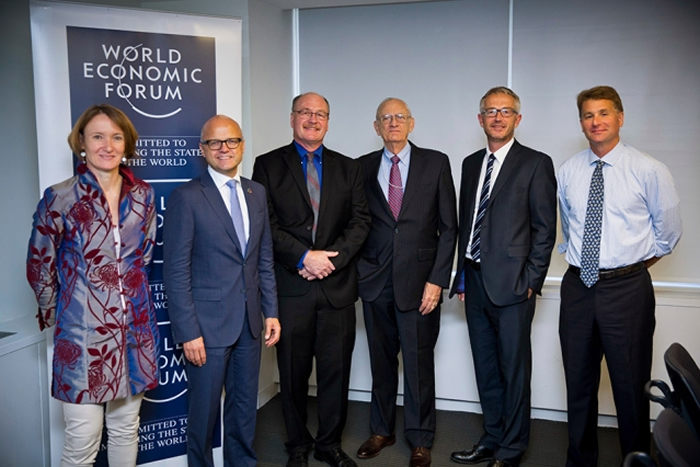Addressing climate change in the industry
With full intentions of confronting the challenge of climate change head on, is the mission of the Oil and Gas Climate Initiative (OGCI). The two-year-old organization comprised of 10 major oil and gas companies, is one not commonly associated with the industry: to catalyze practical action to reduce greenhouse gas emissions.
Last October the OGCI committed to support the Paris climate agreement’s target of capping the rise in mean global surface temperature since preindustrial times at 2°C by 2100 and and has been working ever since to develop a plan for the industry to help advance this objective.
To that end, the OGCI held its second Low Emission Roadmap Roundtable on September 23rd at the World Economic Forum in New York City. During the three-hour event, timed to coincide with the city’s annual Climate Week, the OGCI sought input from stakeholders as they develop practical steps for reducing the industry’s emissions.
While the formal membership of the OGCI represents about 20% of global oil and gas production, invitations were open to a broader group of industry and environmental non-governmental organizations. To bring academic rigor to the discussion of how to help reduce greenhouse gas emissions in alignment with the 2 C goal, the OGCI partnered in the roundtable with the MIT Joint Program on the Science and Policy of Global Change.
Early in the event, Joint Program Co-Director John Reilly previewed a set of scenarios illustrating the significant transformation of the global energy system that’s needed, and various technology paths that could be pursued, to achieve the 2 C goal. These scenarios were released on September 28th in the Joint Program’s 2016 Food, Water, Energy and Climate Outlook.
Reilly who is also a senior lecturer at the Sloan School of Management commented:“A key to understanding steps that industry can take to reduce greenhouse gas emissions are estimates of emissions pathways consistent with stabilization of greenhouse gases in the atmosphere. Our contribution to the discussion was to develop illustrative pathways and to suggest the potential role of a variety of low-carbon technologies in enabling deep emissions cuts, emphasizing that uncertainty in climate response and in technology development call for a risk-based planning process.”
Joint Program Co-Director Emeritus Henry D. Jacoby, the William F. Pounds Professor of Management (Emeritus) at the MIT Sloan School of Management, who moderated the Roundtable, added: “There is a growing effort in the international negotiations to involve non-state actors in managing climate risk, and this OGCI effort is a timely response.”
To that end, the Roundtable included opening presentations by Vidar Helgesen, the minister of climate and environment of Norway, two executives of OGCI companies — Bjorn Otto Sverdrup of Statoil and Valérie Quiniou-Ramus of Total — and Granville Martin from JP MorganChase. The event covered both the intentions and plans of the OGCI member companies and active discussion of ways they could make their most effective contribution to the goals of the Paris Agreement.
The OGCI chose to partner with the MIT Joint Program because it is “one of the key research centers that’s driving the thinking around the energy transition, with strong technical capabilities,” said OGCI Executive Board Chair Gerard Moutet. “The MIT Joint Program’s input at the Low Emission Roadmap Roundtable, along with that of OGCI stakeholders, helps us to determine what oil and gas companies should focus on to enable an efficient energy transition to zero net emissions,” Moutet added.
Informed by the Joint Program’s analysis that a sharp turn in the current direction of the energy system is needed, the discussion centered on how fast the system could respond; whether a technological revolution was already underway that would sweep aside the fossil energy industry; the need to protect and expand forest carbon sinks; and prospects for global carbon pricing, which many in attendance deemed essential to providing enough incentive for investment in low and zero-carbon sources of energy.
Practical steps the OGCI is considering to reduce greenhouse gas emissions include improving the energy efficiency of their operations and products, developing carbon capture and storage, reducing carbon dioxide and methane emissions by utilizing gas instead of flaring it, and developing and deploying new low-carbon energy technologies.
Viewing private sector engagement as essential to solving the climate problem, the Joint Program has for 25 years engaged with industry, including OGCI member companies, on comprehensive studies of the impact of the changing climate, and the need to transform the energy system.
Charlotte Wolff-Bye, host and organizer of the roundtable; co-chair of the OGCI Low Emission Roadmap work stream; and vice president for sustainability at Statoil concluded: “Through its comprehensive modeling and analysis, the MIT Joint Program provided us with useful insights into the nature and timeline of changes that will be needed to transition to a lower-carbon energy system.”
More information: Massachusetts Institute of Technology (MIT)



Comments are closed, but trackbacks and pingbacks are open.